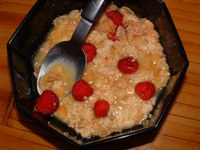Prairie Fare: Does Your Stomach Ever Interrupt Your Work?
(Click an image below to view a high-resolution image that can be downloaded)
By Julie Garden-Robinson, Food and Nutrition Specialist
NDSU Extension Service
Oh, no, I thought to myself. My stomach was going to growl loudly enough to interrupt a meeting.
This is more than a little embarrassing, especially among casual acquaintances.
I usually grab a small snack before I go to a 10 a.m. meeting, but I answered a phone call. I grabbed a water bottle and dashed to the meeting with about a minute to spare.
I took a big gulp of water, but my stomach knows when I am trying to trick it with noncaloric beverages. It wanted food. Now, incessant gurgling was forthcoming.
I looked up sheepishly as I pretended to take notes. Then I heard a nearby stomach grumble sympathetically. Next time, I will bring granola bars for everyone.
Does your stomach ever talk to you? Maybe you feel a little hunger pang as it politely sends the message, “Please send a little food this way.” If you ignore the hint, the rumble may grow louder and eventually it may yell, “Feed me right now!”
If you wait too long, you might get a headache or even feel “hangry” (hungry-angry).
Perhaps you skipped breakfast and your stomach starts scolding you midmorning. When our stomachs are running on empty, we may feel tired and unable to focus on our tasks. Our brain doesn’t function well without nourishment. Refueling your body and brain has many benefits for people of all ages.
A few weeks have passed in the new school year, and families are re-establishing a morning schedule. Parents should remember the role of breakfast in school performance. If you don’t have enough time to eat at home, many schools have a breakfast program.
Eating “something” is better than eating nothing. However, researchers have found that certain foods keep us energized longer.
Perhaps your mom or dad insisted that you eat your oatmeal when you were a child. As we learn with age, parents usually are right. Several studies back up the idea of enjoying more oatmeal.
Researchers studied the role of breakfast composition on the ability of children to learn and pay attention, according to a study published in the Journal of Physiology and Behavior.
For three weeks, 30 children ages 9 to 11 had no breakfast or had ready-to-eat (low-fiber) cereal or oatmeal. The children completed a variety of tests that assessed their ability to listen, think and remember.
In general, the children who had oatmeal had improved memory and better listening skills. Oatmeal is higher in protein and fiber content than many ready-to-eat cereals, providing a more sustained release of energy throughout the morning. If you add some fiber-rich fruit and yogurt to the oatmeal, you are improving the nutrition even more.
Many studies have shown that eating breakfast improves nutrition. Researchers have reported that children who eat breakfast are more likely to meet their needs for calcium, iron, riboflavin, folic acid, iron, vitamins A and D, and other nutrients.
In fact, breakfast eaters tend to eat more healthfully all day. Breakfast skippers usually don't make up for the nutrients they missed at breakfast, but they often more than make up for the 300 calories they skipped. Enjoy some protein, such as an egg or peanut butter, to keep you feeling full longer.
Eating a healthful breakfast can help you meet your fruit and fiber recommendations. A fiber-rich diet can help lower blood cholesterol and reduce your risk of heart disease. Most people shortchange themselves of the 25 or more grams of fiber recommended daily. Fuel yourself with a fiber-rich bowl of whole-grain cereal, such as oatmeal, topped with banana or strawberry slices.
Some researchers have reported that breakfast may prompt a longer life. In one study, people who lived to be 100 or older were more likely to report eating breakfast.
Fuel your body and brain with nourishing food every morning. Add variety to your diet by choosing foods from three or four different food groups, such as a grain, meat, fruit and milk.
Have some protein. Research shows that people who eat a protein-containing breakfast perform better on tests involving thinking and concentration. For example, having a glass of milk, container of yogurt, piece of cheese, peanut butter on your toast or a hard-cooked egg all will add protein.
Choose cereal wisely. When shopping, look high on the shelves instead of at eye level or lower, where the kids cereals often are placed. Read the Nutrition Facts labels carefully. Compare fiber, sugar content, vitamins and minerals.
Choose whole-grain cereals and whole-grain breads more often. To select whole-grain foods, check the first couple of items on the ingredient list. For example, look for oatmeal, whole wheat or whole grain. Look for a health claim on the package.
I need to eat a little more for breakfast or take part of it to work with me for sustained energy throughout the morning. Here are some sample breakfast menus:
- Oatmeal with raisins and low-fat milk or yogurt
- Whole-grain cereal with sliced bananas and milk
- Peanut butter on whole-wheat toast, apple slices and low-fat milk
- Minipizzas made with English muffins, pizza sauce, cheese, Canadian bacon or other toppings and orange juice
- Scrambled eggs, whole-wheat toast, orange slices and low-fat milk
- Leftover pizza, sliced cantaloupe and low-fat milk
- Scrambled eggs with salsa wrapped in tortillas, sliced peaches and low-fat milk
Visit https://www.ag.ndsu.edu/food and click on “Recipes,” then “Breakfast,” for a variety of breakfast recipes to try.
(Julie Garden-Robinson, Ph.D., R.D., L.R.D., is a North Dakota State University Extension Service food and nutrition specialist and professor in the Department of Health, Nutrition and Exercise Sciences. Follow her on Twitter @jgardenrobinson)
NDSU Agriculture Communication - Sept. 28, 2017
| Source: | Julie Garden-Robinson, 701-231-7187, julie.garden-robinson@ndsu.edu |
|---|---|
| Editor: | Ellen Crawford, 701-231-5391, ellen.crawford@ndsu.edu |



